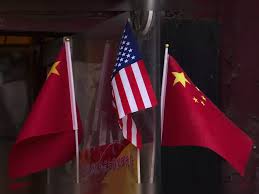Trade War Tensions: The Toll on China’s Corporate Giants

China has warned that Trump’s tariffs could lead to a global trade war and that the increased costs will be passed on to American consumers, raising prices and threatening a major global economic recession. China warns that this trade war is not only harmful to China but also to the global trading system. At the two sessions of the National People’s Congress (NPC) and the National Committee of the Chinese People’s Political Consultative Conference (CPPCC) in March 2025, China announced that its official growth target would be around 5% this year and 2025 but stressed that achieving this goal will not be easy in light of the current US trade war.
As for the most prominent negatives and pressures facing the Chinese economy due to US tariffs, the most prominent are: We note that Chinese exports are facing unprecedented pressures, as Chinese products exported to the United States are now facing the highest tariff barriers in history, exceeding 100%. This negatively impacts the competitiveness of Chinese products, especially labor-intensive products such as textiles, furniture, and some electronic products.
It is also expected that a number of Chinese sectors that rely heavily on exports, such as consumer electronics and textiles, will be significantly affected by these policies. These developments, taken together, may impact China’s GDP growth rate. Therefore, achieving China’s 5% economic growth target for 2025 will require further Chinese support for domestic economic policies, especially in light of the significant decline in global demand. Furthermore, the United States’ imposition of additional tariffs on Chinese imports will have multiple impacts on the Chinese economy, including short-term shocks and long-term structural adjustments in a number of Chinese industries.
Beijing has vowed to take countermeasures in response and warned that the new US tariffs will cripple and restrict global supply chains and harm Washington’s interests. According to Beijing’s customs data, total Chinese goods sales to the United States last year exceeded $500 billion, representing 16.4% of the country’s exports. The tariffs threaten to undermine China’s current economic recovery plan, which follows a long-term plan to address a long-standing debt crisis in the real estate sector and a decline in consumption across several sectors, a slowdown Beijing sought to slow through extensive fiscal stimulus last year. China’s most prominent exports to the United States are likely to be the most affected, as China is the main supplier of US goods, from electronics and electrical machinery to textiles and clothing.
In March 2025, China imposed 15% tariffs on coal and liquefied natural gas imports from the United States. US exports of crude oil, agricultural machinery, large engine vehicles, and pickup trucks also face 10% tariffs. These measures are aimed at undermining Trump’s support base, particularly among rural Americans who voted for him last year.
At the same time, the current US escalation with China threatens not only the performance of the Chinese manufacturing sector but also the interconnected supply chains that form the backbone of the country’s economy. With millions of jobs in China dependent on export flows, fears are growing within China of a deeper slowdown at a time when the Chinese leadership is striving to stimulate domestic demand and enhance its technological independence. China’s immediate response to the United States came after US tariffs on Chinese goods doubled, while Beijing responded with further tariffs and restrictions on US companies operating in China. For its part, China will impose an additional 50% tariff on American goods, in addition to the 34% it already announced, in retaliation for the tariffs imposed by President “Trump” in the escalating trade war between the world’s two largest economies.
The comprehensive tariffs, which will include an additional 84% tariff on all US goods, will affect US banks, semiconductors, and other goods. It is expected that the total Chinese tariffs on US restrictions will exceed 100% once the players enter into force. A significant portion of Dutch agricultural products, as well as those from Yemen, have also been affected by additional tariffs previously imposed by China.
US Secretary of Defense “Scott Bessent” then described China’s decision to impose retaliatory tariffs of 84% on US imports as an unfortunate and losing move for Beijing, emphasizing that he must work hard to resolve the issue through dialogue. The United States needs to strengthen its domestic air conditioning system, while China needs to stimulate domestic consumption, which is the core of the economy for both sides. Another concern is the United States’ ban on the export of radioactive metals to the United States, which reflects an escalation in the war between us.
There is a broad consensus among economists that tariffs will lead to a rise in the number of American consumers across a range of consumer groups, as companies compete with some or all of their increased costs. The list of affected American products could include a wide range of products and services. Some American companies may also limit the import of Chinese products, which they are obligated to import or collect, as they may want to obtain these products at a lower price. Doors have already been created for manufacturing products in the United States using imported components. For example, many car components cross the US-Mexico border several times before the car is fully assembled. Car names are expected to begin with Trump’s tariffs. Therefore, the cost of a car manufactured using Mexican parts is limited to $4,000 to $10,000, depending on the type of vehicle.
Analyzing our previous report on tariffs during the first term, the tariffs announced by companies during the first presidential term increased the average price of steel and aluminum in the United States by 2.4% and 1.6%, respectively, according to the U.S. International Trade Commission. The U.S. tariffs on tax washing machines between 2018 and 2023 would increase the price of washing equipment by 34%, according to the U.S. Official Resistance.





